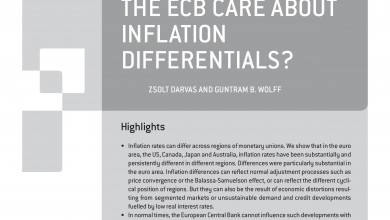At a famous summit in June 2012, the European leaders announced that they intend to “break the vicious circle” between banks and sovereigns. This decision started a new step in European integration. Arguably, the creation of the so-called banking union constitutes the most significant deepening of policy integration since the start of the euro. The aim of the banking union was to make the financial system more resilient and decrease the link between banks and states. To achieve this, three major steps needed to be undertaken: first, bank supervision had to be moved from the national to the European level. Second, mechanisms for bank resolution, in particular of banks operating across borders, needed to be developed. Third, mechanisms to reduce the risk for taxpayers and share the remaining risks across the union needed to be devised.
Policy makers have made significant progress on all three; however, the work is not finished. In particular, the link between national public resources and fragile banks will remain in place for quite some time. The biggest success so far is the creation of a strong and centralized supervisor in the European Central Bank. Within about a year, the ECB has not only hired 1000 new experts for its banking supervision, it has also brought substantial transparency to Europe’s banks by assessing the quality of the balance sheets, harmonizing the reporting and running a stress test on the balance sheets. Banks that fell below certain thresholds for risk-weighted capital in these stress tests are increasing their capital to become more resilient. Yet, important building blocks remain unfinished.
A first important question is whether the ECB as a newly established supervisor will be able to ensure that deposits can circulate freely within banking groups. In the course of the crisis, national supervisors have put limits on subsidiaries, in order to reduce the exposure of depositors to capital flows and risks in other countries. This policy has rendered bank integration across borders less beneficial and has undermined financial integration. Yet, abandoning the policy altogether has implications for deposit insurances and will therefore remain controversial.
A second important question is how the ECB and authorities will continue the process of cleaning and restructuring the banking system. The data show that significant non-performing exposures remain in the system and as growth and inflation numbers deteriorate, these are bound to increase. Profitability in the banking system is also low according to IMF analysis. I therefore expect more bank consolidations. It is of central importance for financial integration, whether this consolidation process will be national or European.
A third important question is about the participation of private creditors in bank restructuring and resolution. The new European legislation establishing the banking union foresees a dramatic shift in the policy stance. While up to quite recently, tax-payers were heavily involved in the rescuing of banks, the new rules aim to reverse this picture and have the creditors of banks pay for the losses in the banks. The success of this legislative initiative will crucially depend on the credibility to stick to the new rules in case banks face problems. Bail-in will be credible if bank supervisors force banks ex-ante, i.e. before problems surface, to prove that they can withstand a negative shock without causing a new financial crisis.
If bail-in is insufficient to solve banking problems, then fiscal resources will again be used. Given Europe’s current political integration, the joint funding mechanisms developed will only suffice for small to medium-sized banks. For the large banks, ad-hoc political agreements will have to be found. This is unavoidable as long as Europe does not achieve greater political integration. In turn, it means of course that the link between banks and states will remain in place.
Fourth, to reduce the link between banks and national sovereigns, bail-in and risk sharing will not be sufficient. Banks will also have to decrease their exposure to sovereign debt and other claims of the countries in which they are located. In the course of the crisis, this exposure has increased substantially.
Overall, the process of repairing and deepening financial integration in the EU and the euro area in particular is bound to take time. The crisis and the political tensions of the last years have left a mark on the confidence of investors. However, the establishment of a strong supervisor in the ECB and the significant progress made in the institution building on bank resolution should rightly be considered a game changer. The more the ECB establishes itself as a supervisor, the more financial integration will advance. Creditors of banks will increasingly look for European solutions to banking problems as they can rightly claim that the ECB has been supervising the banks. Politics will continue to matter for financial integration, also for the political relations between the continent and the UK with the EU’s financial centre, the city of London.

